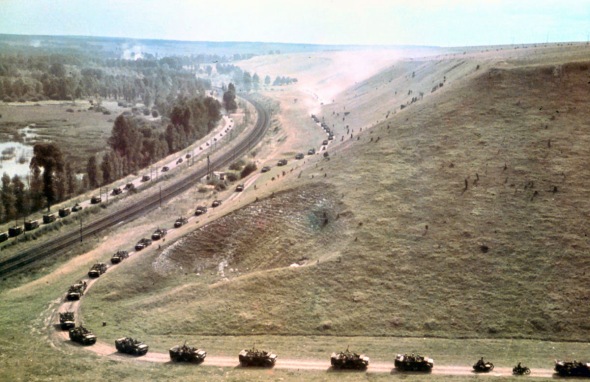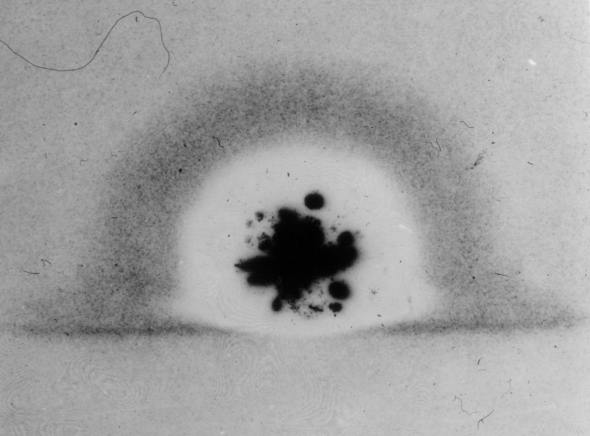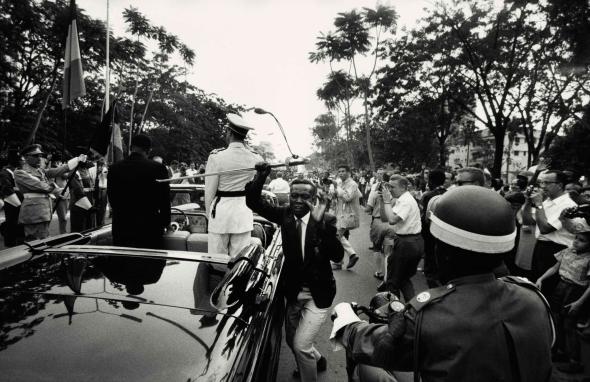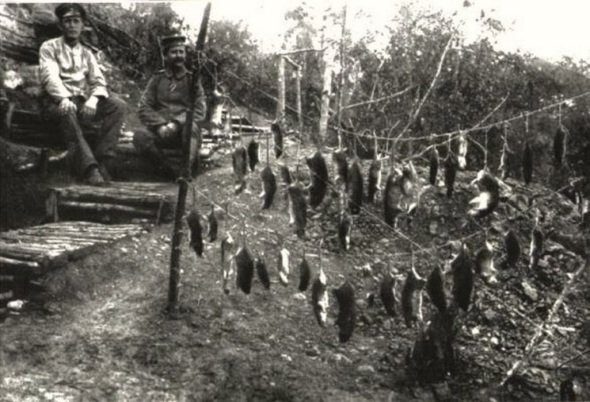Wesel, Germany shows the effects of carpet bombing by the Allies; ca. 1945
97% of the city was destroyed.
Wesel became a target of the Allies, particularly in its strategic position as a depot with bridges on the Rhine. On the 16, 17, 18 and 19 February 1945, the town was attacked by the Royal Air Force with impact and air-burst weapons and almost entirely destroyed.
On 23 March, Wesel came under the fire of over 3,000 guns when it was bombarded anew, in preparation for Operation Plunder. That day 80 Lancasters from No. 3 Group RAF attacked Wesel Then that night of 23/24 March, 195 Lancasters and 23 Mosquitos of RAF Bomber Command No. 5 Group aided in the softening up of the German defenders. 97% of the town was destroyed before it was finally taken by Allied troops and the population had fallen from almost 25,000 in 1939 to 1,900 in May 1945.
The town was taken quickly with 36 civilian casualties. Field-Marshal Montgomery said “the bombing of Wesel was a masterpiece, and was a decisive factor in making possible our entry into the town before midnight.”
(Source)
Tereska, draws a picture of “home” while living in a residence for disturbed children; Poland, 1948.

This is a fantastic example of the art style known as Art Brut. Collectively, the art of children, the insane, and those who are “outsiders”, this style has been described as a pure or raw form of artistic expression.
Life Magazine: “Tereska Draws Her Home”, photo by David Seymour, Vol. 25, No. 26, December 27, 1948, p. 16.
The original caption reads as follows:
Children’s wounds are not all outward. Those made in the mind by years of sorrow will take years to heal. In Warsaw, at an institute which cares for some of Europe’s thousands of “disturbed” children, a Polish girl named Tereska was asked to make a picture of her home. These terrible scratches are what she drew. (p. 17)
This photograph was taken by Chim (David Seymour) in a home for emotionally disturbed children (Warsaw, 1948). It’s generally agreed upon that the subject, Tereska, was a victim of the Holocaust.
This was part of a series on Europe’s postwar children commissioned by UNICEF.
Update:
Tereska’s family had no idea that her photo is famous around the world and used by psychologists to research what war does to children’s mind.
It turns out that Tereska – “Niuńka” as the family called her – has never been to concentration camp. Her drawing may show war, of course, but as children were ask to draw “home” it may show rubble. Tereska’s house was ruined during Warsaw uprising seconds after she and her older sister managed to run away. We don’t know exactly what she experienced since there are no living family members who were there with her, but it happened during Wola massacre so we can just imagine. During bombing a fragment of brick hit Niuńka. Her central nervous system was harmed and ever since she had physical and mental problems.
Tereska died tragically in 1978 in a mental hospital nearby Warsaw.
• More Info (in Polish)
The first light of the Trinity test, the first atomic bomb detonation, burns through film emulsion. New Mexico, July 16th, 1945, 5:30am
The photo was by Brlyn Brixner. He was a real innovator in photography and an official photographer for the Manhattan Project. Brixner had something like 50 cameras set up that day, of all different types. Some could record at speeds of 10,000 frames per second.
If you watch the film footage that Brixner shot, you can see that the ball goes out of the frame briefly before the camera shoots up to follow it. This was Brixner’s fault. As he later said in an interview:
I was so amazed, though, initially that I just let the camera sit there. Then suddenly I realized that the ball of fire was going out of the field of view… for the first twenty seconds on the standard-speed camera it’s just sitting stationary, then suddenly you will see the field of view jump as the ball of fire is going out of the top of the frame.
German SS guards, exhausted from their forced labor clearing the bodies of the dead, are allowed a brief rest by British soldiers but are forced to take it by lying face down in one of the empty mass graves; ca. 1945
Taken during the liberation of the Bergen-Belsen concentration camp.
(Source)
There’s a famous quote from BBC journalist Richard Dimbleby, who was present at the liberation of this very camp.
Here over an acre of ground lay dead and dying people. You could not see which was which… The living lay with their heads against the corpses and around them moved the awful, ghostly procession of emaciated, aimless people, with nothing to do and with no hope of life, unable to move out of your way, unable to look at the terrible sights around them … Babies had been born here, tiny wizened things that could not live … A mother, driven mad, screamed at a British sentry to give her milk for her child, and thrust the tiny mite into his arms, then ran off, crying terribly. He opened the bundle and found the baby had been dead for days.
This day at Belsen was the most horrible of my life
A moment of humanity on the Eastern Front as a German soldier tends to a wounded Russian civilian; ca. 1941
Man riding a monowheel; ca. 1931

With 2 or three revisions from 1923 to at least 1933 the Motoruota was the most enduring Monowheel model of it’s time. Here in 1931 with a Swiss customer, Mr Gerdes in Arles, France en route to Spain.
A monowheel is a one-wheeled single-track vehicle similar to a unicycle. However, instead of sitting above the wheel, the rider sits either within it or next to it. The wheel is a ring, usually driven by smaller wheels pressing against its inner rim. Most are single-passenger vehicles, though multi-passenger models have been built.
Hand-cranked and pedal-powered monowheels were built in the late 19th century; most built in the 20th century have been motorized. Some modern builders refer to these vehicles as monocycles, though that term is also sometimes used to describe motorized unicycles.
Today, monowheels are generally built and used for fun and entertainment purposes, though from the 1860s through to the 1930s, they were proposed for use as serious transportation.
(Source)
Afro-German soldier of the Nazi Germany – Free Arabian Legion; ca. September 1943
The Free Arabian Legion provided an opportunity for German blacks who wanted to fight for the Reich. The unit’s founder was Haj Amin Al Husseini, an anti-Semite Muslim.
The Legion included Arab volunteers from the Middle East and North Africa, war prisoners who opted to fight instead of go to prison … and blacks. In the end, the Legion saw very little combat action—and most of that during the Allies’ Operation Torch in French North Africa.
Nazi racial ideology in practice could be very inconsistent:
- 57% of Soviet prisoners and millions of Soviet civilians die as a result of intentional Nazi policy. But a Russian volunteer battallion is raised to fight for Nazi Germany
- Several groups of Africans fighting for France are murdered upon capture by German troops. But some African volunteers are enlisted in the German armed forces
- Ethnic Germans in Poland are deemed superior to Poles. But these ethnic Germans, when found guilty of rape, are punished and declared as not being like “true” German men
- Non-white colonial POWs who fought for France are treated badly and suffer worse mortality rates than white French POWs. But yet the Germans collaborate with certain groups of non-whites.
The disaster at the 1955 Le Mans endurance race – “Eighty-three spectators and driver Pierre Levegh died at the scene, whilst 120 more were injured in the most catastrophic accident in motorsport history.”
The 1955 Le Mans disaster occurred during the 24 Hours of Le Mans motor race, when Pierre Levegh’s state of the art Mercedes-Benz 300 SLR ran into Lance Macklin’s Austin-Healey 100 and crashed into the audience, causing large fragments of racing car debris to fly into the crowd. Eighty-three spectators and driver Pierre Levegh perished at the scene with 120 more injured in the most catastrophic accident in motorsport history.
(Levegh’s car had a special magnesium alloy body that burned incredibly hot when it ignited and water obviously doesn’t help with magnesium fires.)
How the accident happened:
The 1955 24 Hours of Le Mans began on 11 June 1955, with Pierre Levegh behind the wheel of the #20 Mercedes-Benz 300 SLR run by Daimler-Benz. American John Fitchwas Levegh’s assigned partner in the car, and he would take over driving duties later. Competition between Mercedes, Jaguar, Porsche, Ferrari, Aston Martin and Maseratiwas close, with all the marques fighting for the top positions early on. The race was extremely fast, with lap records being repeatedly broken.
At the end of Lap 35, Levegh was following Mike Hawthorn’s leading Jaguar D-type, just as they were entering the pit straight. Hawthorn had just passed Lance Macklin’s slower Austin-Healey 100 when he belatedly noticed a pit signal to stop for fuel. Hawthorn slowed suddenly in an effort to stop rather than make another lap. Hawthorn’s Jaguar, with the new disc brakes, could decelerate much faster than other cars using drum brakes, such as Levegh’s Mercedes. The sudden, unexpected braking by Hawthorn caused Macklin in the Healey to brake hard, throwing up a small cloud of dust in front of Levegh, who trailed close behind. Macklin then swerved across the centre of the track, attempting to re-pass the slowing Jaguar, but also apparently out of control. Macklin had not noticed Levegh nor Juan Manuel Fangio, in another 300 SLR, approaching rapidly from behind. Fangio was in second place at the time, but directly behind, and attempting to lap Levegh.
Levegh, ahead of Fangio on the track, did not have time to react. Levegh’s car made contact with the left rear of Macklin’s car as he closed rapidly (at about 240 km/h (150 mph)) upon the slowed car.
When Levegh’s 300 SLR hit Macklin’s Austin-Healey from behind, his car became airborne, soaring towards the left side of the track, where it landed atop the earthen embankment separating spectators from the track itself. The car struck the mound at such speed and angle that it was launched into a somersault, which caused some parts of the car, already damaged and loosened by the collision, to be flung from the vehicle at very great speeds. This included the bonnet and the front axle, both of which separated from the frame and flew through the crowd.
The bonnet decapitated tightly jammed spectators like a guillotine. With the front of the spaceframe chassis—and thus crucial engine mounts—destroyed, the car’s heavy engine block also broke free and hurtled into the crowd. Spectators who had climbed onto trestle tables to get a better view of the track found themselves in the direct path of the lethal debris. Levegh was thrown free of the tumbling car, and his skull was fatally crushed when he landed.
As the somersaulting remains of the 300 SLR decelerated, the rear-mounted fuel tank ruptured. The ensuing fuel fire raised the temperature of the remaining Elektron bodywork past its ignition temperature, which was lower than other metal alloys due to its high magnesium content. The alloy burst into white-hot flames, sending searing embers onto the track and into the crowd. Rescue workers, totally unfamiliar with magnesium fires, poured water on the inferno, greatly intensifying the fire. As a result, the car burned for several hours. Official accounts put the death total at 84 (83 spectators plus Levegh), either by flying debris or from the fire, with a further 120 injured. Other observers estimated the toll to be much higher.
Fangio, driving behind Levegh, narrowly escaped the heavily damaged Austin-Healey, which was now skidding to the right of the track, across his path. Macklin then hit the pit wall and bounced back to the left, crossing the track again. He struck the barrier near the location of the now burning 300 SLR, causing the death of a spectator, although Macklin survived the incident without serious injury.
(Source)
Aftermath:
Winston Churchill with his chiefs of staff in the garden of No. 10 Downing Street, on the day Germany surrendered to the Allies; May 7th, 1945

Original caption: 10 Downing Street garden, London, England 7th May 1945, Chiefs of Staff at Downing Street, Back Row, L-R; Major General Hollis, General Sir Hastings Ismay (1887-1965), Front Row, L-R; Sir Charles Portal, Marshal of the RAF, Field Marshal Sir Alan Brooke, Prime Minister Winston Churchill, Admiral of the Fleet, Sir Andrew Cunningham
A young man snatches the ceremonial sword of King Baudouin of Belgium during a procession with the newly appointed President Kasa-Vubu, on the eve of the independence of the Belgian Congo, Leopoldville; June 30, 1960
Ambroise Boimbo was a Congolese citizen who snatched the ceremonial sword of King Baudouin I of Belgium on June 29, 1960 in Léopoldville (now Kinshasa) on the eve of the independence of the Belgian Congo. He was a former soldier who originated from Monkoto in the Équateur Province.
The king’s entourage was driving from the airport into the city when it slowed to enable the monarch to stand and salute the flag of an honour guard of the Force Publique drawn up by the side of the road. A widely published photograph, taken by journalist Robert Lebeck, shows an exuberant Ambroise Boimbo, in jacket and tie, flourishing the sword while Baudouin and Congolese President Joseph Kasa-Vubu appear unaware of the incident. Further photographs taken by Lebeck show Boimbo encircled by Belgian and Congolese colonial gendarmes, as they wrestled him to the ground. According to media reports the “nationalist demonstrator” was taken away in a police vehicle but released later the same day at the king’s request. The sword was apparently quickly retrieved and returned to King Baudouin, who was filmed wearing it at the Independence speech-making ceremonies the next day on June 30.
To some commentators the seizure of the sword symbolized the independence of the Congo, although others saw it as simply an instance of high-spirited behavior at a time of celebration.
Mechanized Column of the 7th Panzer-Division in France; ca. 1940

Shown here is a mechanized column of the 7th Panzer-Division, commanded by General major Erwin Rommel, on the move during the Blitzkrieg through France in the last days of May 1940. The photo was taken by General Rommel himself.
The second railway station of Bruges; ca. 1890
It was built in 1886, to replace the first railway station that was built in Classical style (the old one was moved to Ronse, because it’s the third oldest in the world).
It was decided in 1899 that this one was a nuisance to the neighbourhood, since it cut off the Western part of Bruges. The works for a new railway station outside the city started in 1910, but were delayed by the first world war. Only in 1936 was the third railway station finished.
Ten years later the second building (this one) was demolished.
Four-year-old Michael Finder of East Germany is tossed by his father into a net held by firemen across the border in West Berlin. The apartments were in East Berlin while their windows opened into West Berlin; October 7, 1961
His father jumped after him:
His mother had jumped before him:
Escaping on Bernauer Strasse – video of the father jumping (at 00:46).
The soviet occupation zone in Germany (and Berlin) suffered from serious movements of educated individuals from their sectors toward the west throughout the 1950’s. This brain drain encouraged the Soviet Union to begin construction of a “Fascist Protection Wall” that would keep East Germans protected from “Fascism” that the Western Allies had “not eradicated in their sectors. ”
Of course, this wall was only really to keep East Germans from emigrating to the West. The wall later became the Berlin Wall.
These apartments were along Bernauer Straße (Bernauer Street) in Berlin. A line which saddled the border between East and West Berlin. After the wall was first constructed in 1961, many escape attempts were made through these apartment blocks. So much so, that the soviets had to brick up the windows and raid the apartments of the people who lived there. They evicted the people living in those apartments. So what you’re seeing when these people are jumping from the 4th floor are the people who are making a last ditch attempt at the West before all their (relatively safe) options out of East Berlin were gone for good.
These apartments were later torn down and the Berlin Wall that most of us picture in the news reels, and have chunks of in our museums all over the world, was erected.
Here are some historical photos for reference.
Mayor Willy Brandt taking a stroll along Bernauer St. You can clearly see the bricked up windows here; Winter 1963:
Comparison of the area 1963 vs 2011 – (the poles mark the location of the old apartment building that stood on the location in 1961):
Hungarian Jewish children and an elderly woman on the way to the death barracks of Auschwitz-Birkenau, ca. May 1944
“From the chimneys of the Vatican, white smoke rises,
a sign the Cardinals have chosen themselves a Pope.
From the crematoria of Auschwitz, black smoke rises,
a sign the conclave of Gods hasn’t yet chosen,
the Chosen People.
After Auschwitz, no theology:
the inmates of extermination bear on their forearms
the telephone numbers of God,
numbers that do not answer
and now are disconnected, one by one.
After Auschwitz, a new theology:
the Jews who died in the Shoah
have now come to be like their God,
who has no likeness of a body and has no body.
They have no likeness of a body and they have no body.”
– Smoke by Jacob Glatstein
“Lafayette, we are here.” US General John J. Pershing salutes the grave of the Marquis de Lafayette as he arrives in France during WWI.
The Marquis de Lafayette is an amazing and fascinating guy. Besides a hero of the American Revolution, he was also one of the few true “Good Guys” of the French Revolution. In France he fought both for representative democracy and preservation of stability and the monarchy. He was horrified by the chaos that that revolution became.
Fun Fact: Lafayette loved America so much he was buried with soil from Bunker Hill.
































